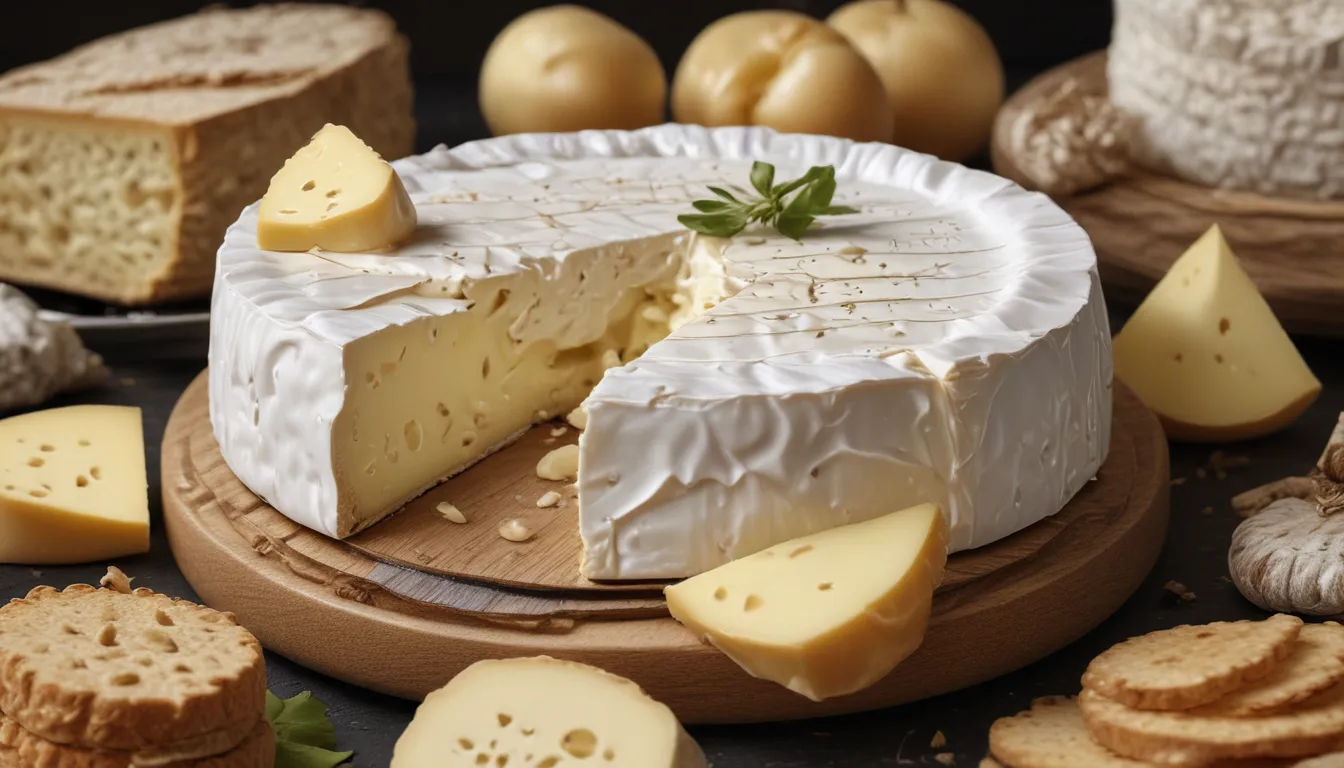The pictures in our articles might not always show exactly what the text is talking about. We use these images to make the article more interesting and eye-catching. They are there to add to the text, but not to replace it or show every detail.
If you're a cheese aficionado or simply curious about the world of dairy delights, Camembert cheese is sure to capture your taste buds and culinary imagination. Originating in the scenic region of Normandy, France, Camembert is a beloved French cheese renowned for its creamy texture, distinct flavor, and rich cultural significance. In this article, we'll take a closer look at this iconic cheese and uncover 12 fascinating facts that will deepen your appreciation for this culinary masterpiece.
Unveiling the Rich History of Camembert
Camembert cheese traces its roots back to the late 18th century in Normandy, France. Named after the picturesque village of Camembert, where a resourceful farmer named Marie Harel is credited with its creation, this cheese has a storied history steeped in tradition and craftsmanship.
The Art of Traditional Camembert Making
Crafted using raw cow's milk in its traditional recipe, Camembert boasts a unique flavor profile and complexity that sets it apart from other cheeses. However, for those concerned about food safety, pasteurized versions of Camembert are also available without compromising on taste and quality.
Embracing the Soft-Ripened Charm of Camembert
As a soft-ripened cheese, Camembert undergoes a maturation process that results in a bloomy white rind and a lusciously creamy interior. This aging process imbues the cheese with its signature texture and earthy undertones, making it a true delight for the senses.
Recognizing the AOC Certification of Authentic Camembert
Authentic Camembert cheese is granted the prestigious Appellation d'Origine Contrôlée (AOC) certification, which guarantees that the cheese is crafted using specific methods and ingredients within the designated region of production. This certification underscores the commitment to preserving the authenticity and heritage of Camembert.
Celebrating the Versatility of Camembert
Camembert is a versatile cheese that lends itself to a myriad of culinary applications. Whether spread on crusty bread, melted into dishes, or used as a decadent topping for pizzas and burgers, Camembert adds a touch of sophistication and flavor to any dish.
Indulging in Pairings Fit for Camembert
Camembert pairs harmoniously with a diverse array of accompaniments, including fresh fruits, nuts, honey, and a glass of red wine. The interplay of flavors creates a symphony of taste sensations that elevate the experience of enjoying Camembert to new heights.
Embracing Camembert’s Global Appeal
Camembert's popularity transcends borders, with the cheese being exported to numerous countries worldwide. Its widespread availability has made it a staple in international cuisines, captivating cheese enthusiasts with its unparalleled taste and texture.
Paying Homage to Camembert’s Cultural Significance
In France, Camembert holds a place of honor in the realm of culinary culture, symbolizing the essence of French gastronomy. Featured in traditional French dishes and beloved by locals and tourists alike, Camembert embodies the spirit of timeless culinary tradition.
Safeguarding Camembert’s Protected Status
Camembert has been bestowed with a Protected Designation of Origin (PDO) status by the European Union, ensuring that only cheeses produced within a specific geographical area can bear the esteemed label of "Camembert de Normandie." This designation upholds the integrity and authenticity of this iconic cheese.
From Napoleon to Modern Delights: The Legacy of Camembert
With its origins dating back to Napoleon Bonaparte's era, Camembert has enjoyed a legacy of culinary acclaim and popularity. The French emperor's affinity for this cheese helped propel it to fame, solidifying its status as a timeless classic loved by generations.
Exploring Variations for Every Palate
While traditional Camembert is crafted from cow's milk, there are tantalizing variations available that employ goat's milk or a blend of different milk types. These diverse variations offer a spectrum of flavors and textures, catering to a range of taste preferences.
Preserving the Freshness of Camembert
To savor the full splendor of Camembert, it is advisable to store it in the refrigerator at a temperature between 8-10°C (46-50°F). By following proper storage practices, you can ensure that your Camembert maintains its optimal freshness and taste for an extended period.
These 12 captivating facts about Camembert shine a spotlight on the rich history, cultural significance, and irresistible allure of this revered French cheese. Whether relishing it on its own or incorporating it into culinary creations, Camembert continues to enchant cheese enthusiasts with its unmatched flavor and velvety texture.
Embracing the Delight of Camembert
Camembert isn't just a celebrated French cheese; it's a culinary treasure that has captivated palates worldwide. These twelve facts underscore the rich tapestry of Camembert's history, production process, and enduring popularity. From its humble beginnings in Normandy to its status as a beloved delicacy, Camembert embodies the essence of timeless culinary craftsmanship.
Whether you indulge in Camembert as a standalone treat, infuse it into recipes, or pair it with your favorite wine, this cheese promises a sensory journey that transcends borders and traditions. Its versatility makes it an ideal companion for casual gatherings and elegant soirées alike. So, when the craving for a delectable cheese strikes, let Camembert whisk you away on a gustatory adventure through the finest French culinary traditions.
Exploring More Cheese Adventures
For those enchanted by the allure of Camembert, why not embark on a journey to discover other delightful cheese varieties? Explore the tantalizing flavors of Taleggio, a soft cheese with a distinctive taste profile that promises a unique experience. If Brie beckons to you, delve into this French classic that shares a kinship with Camembert in its luxurious creaminess. Lastly, immerse yourself in the enchanting region of Normandy, where these beloved cheeses find their origins, and uncover the culinary heritage that has shaped these timeless delights.
Interactive FAQs for Cheese Enthusiasts
-
What is Camembert?
Camembert is a soft, creamy French cheese made from cow's milk, renowned for its tangy flavor and velvety texture. -
How is Camembert made?
Camembert is crafted by inoculating cow's milk with specific cultures, coagulating the milk, and then aging the cheese to develop its characteristic taste and texture. -
How should I store Camembert?
Store Camembert in its original packaging or wrapped in wax paper in the refrigerator at a temperature of 36-46°F (2-8°C) for optimal freshness. -
Can I eat the rind of Camembert?
The rind of Camembert is safe to eat and can enhance the overall flavor experience of the cheese. -
How do I serve Camembert?
Serve Camembert at room temperature to showcase its flavors, pair it with bread, fruits, or incorporate it into various recipes for a delectable touch. -
Is Camembert suitable for vegetarians?
While traditional Camembert is not vegetarian-friendly due to the use of animal rennet, there are versions available made with microbial or vegetable rennet that cater to vegetarians. -
Can Camembert be frozen?
It's not recommended to freeze Camembert as freezing can alter its texture and compromise its flavor profile. -
Are there variations of Camembert available?
Yes, variations of Camembert crafted from goat's milk or sheep's milk offer diverse flavor profiles for cheese enthusiasts to explore. -
Is Camembert a healthy cheese option?
Camembert, like other cheeses, provides essential nutrients such as protein and calcium but should be enjoyed in moderation due to its higher saturated fat content. -
Can Camembert be substituted with other cheeses?
While Camembert has a unique taste, similar soft, creamy cheeses like Brie or triple-cream cheeses can serve as substitutes in recipes. -
What are traditional dishes or pairings for Camembert?
Camembert pairs well with bread, fruits, and is a key ingredient in dishes like "tartiflette" and "camembert en croûte." -
How can leftover Camembert be utilized?
Leftover Camembert can be repurposed in dishes such as quiches, omelets, or used as a flavorful topping for pizzas, allowing you to savor its unique taste in new culinary creations.
Trustworthy Content for Your Exploration
Our dedication to delivering engaging and reliable content underscores our commitment to providing you with valuable insights and information. Every fact shared on our platform is contributed by real users like you, ensuring a diverse range of perspectives and knowledge. Our meticulous editorial process guarantees the accuracy and authenticity of the information we present, empowering you to explore, learn, and discover with confidence. Trust in our unwavering pursuit of quality and authenticity as you embark on your culinary journey through the world of Camembert cheese and beyond.






